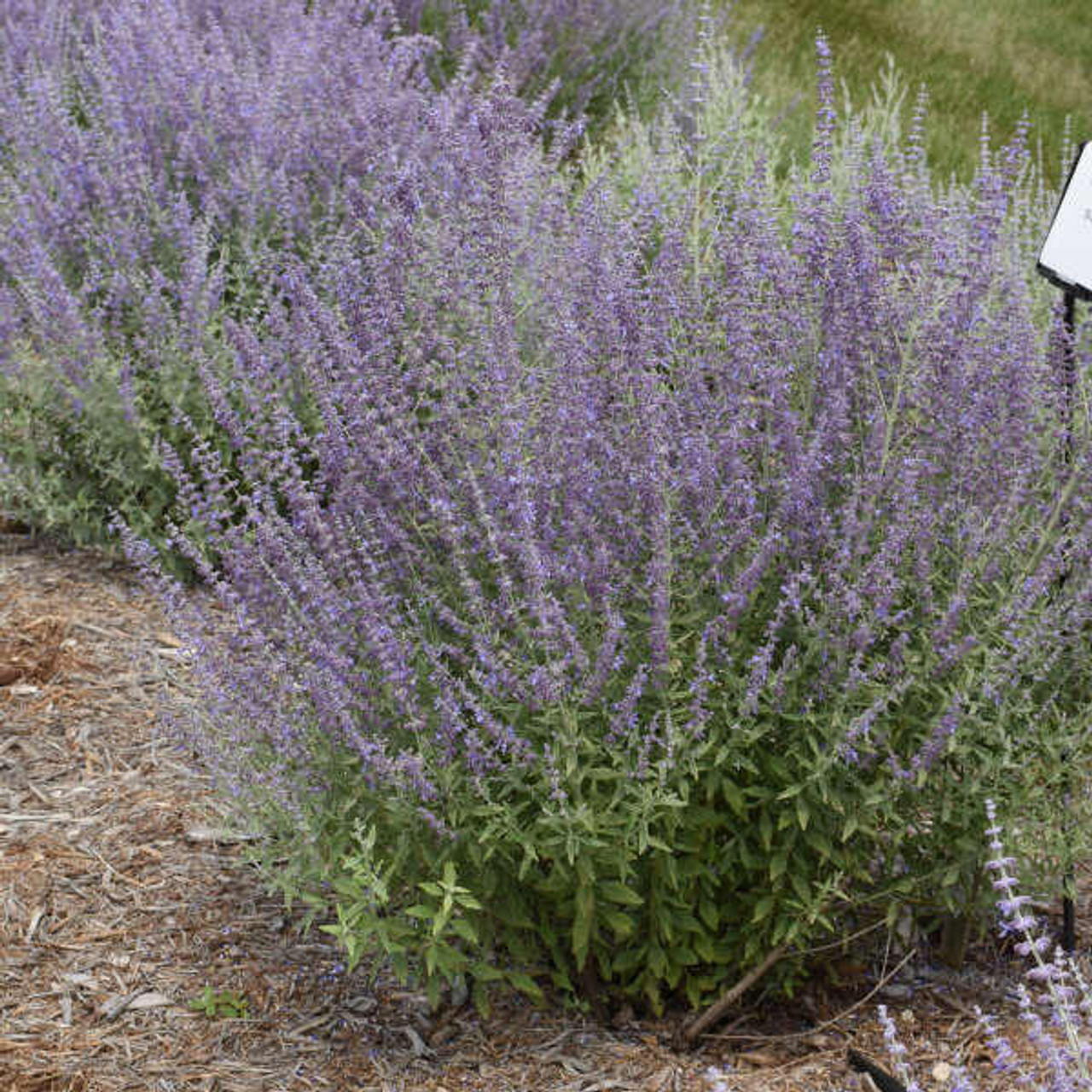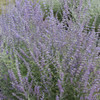Product Description
Perovskia 'Prime Time' PPAF (25) Bare Root Plants
Common Name: Russian Sage
An upgrade to 'Rocketman' with earlier bloom and denser flower spikes. Dusky purple calyxes hold blue flowers. The calyxes remain colorful well into fall, giving the plant the impression it is still in bloom after flowering has ended. The upright habit is made of slightly dissected oval leaves for a very full appearance.
A perfect perennial for hot, dry climates and also exceptionally cold hardy. Perovskia can be used in a wide variety of environments with little attention through the season - a reason they have long been a staple of landscapers. Expect these plants to be a little later to emerge in spring, but also to offer color well into fall.
Height: 30.0-36.0 Inches
Spread: 24.0-30.0 Inches
Hardiness Zones: 4,5,6,7,8,9
Flower Color: Purple-blue shades
Foliage Color: Green shades
Full Sun
Low to Average Water Needs
Poor to Fertile Soil Quality
Bloomtime: Midsummer - Early Fall
Attracts Hummingbirds
Deer Resistant
Seasonal Interest: Dried Seed Heads, Fall Color
Growth Rate: Medium
Border Plant, Cut Flower, Cut Foliage, Dried Flower, Drought Tolerant, Easy To Grow, Fragrant Flowers, Fragrant Foliage, Mass Plantin, Salt Tolerant
Perovskia 'Prime Time' is a show-stopping perennial with captivating lavender-blue flowers that bloom in dense spikes, creating a hazy, dream-like effect in the garden. This relatively new cultivar of Russian sage, first introduced in 2020, boasts a longer blooming season than other varieties, extending the beauty and color of your garden from mid-summer to early fall. Native to Southwest and Central Asia, this hardy and adaptable plant thrives in a variety of conditions, making it a favorite among gardeners of all skill levels. Whether you are a seasoned gardener or just starting out, Perovskia 'Prime Time' is a fantastic choice for adding a touch of elegance and effortless beauty to your outdoor space.
Characteristics
- Flowers Perovskia 'Prime Time' is an early bloomer, displaying its vibrant lavender-blue flowers earlier than most Russian sage varieties. The flowers are arranged in dense spikes that emerge from dusky purple calyxes. Even after the blooms fade, the calyxes retain their color, prolonging the visual appeal of the plant well into the fall.
- Foliage The silvery-green foliage of Perovskia 'Prime Time' provides a beautiful contrast to the vibrant blooms. The leaves are aromatic when crushed, adding another sensory dimension to this captivating plant.
- Growth Habit This cultivar typically reaches a height of 36 inches with a spread of 30 inches. It is known for its strong, upright stems that prevent flopping, maintaining a neat and tidy appearance throughout the growing season. Perovskia 'Prime Time' is also a vigorous grower, quickly filling in gaps in the garden and creating a lush, full look.
- Hardiness and Wildlife Perovskia 'Prime Time' is hardy in USDA zones 4-9b, tolerating temperatures as low as -34°C. It is also rabbit resistant and attracts pollinators such as bees and butterflies, making it a valuable addition to any wildlife-friendly garden.
- Care Requirements Perovskia 'Prime Time' is a low-maintenance plant that requires minimal care. It thrives in full sun and well-drained soil. While it prefers a slightly alkaline pH, it is adaptable to various soil types.
- Planting and Watering The best time to plant Perovskia 'Prime Time' is in late spring or early summer. Water regularly during the first growing season to establish a deep root system. Once established, it is remarkably drought-tolerant, requiring minimal watering even during dry periods.
- Fertilizing and Pruning This plant does not require much fertilizer. However, a light application of compost in the spring can provide beneficial nutrients. Deadheading is not necessary, as it does not increase flower production or lengthen the bloom period. Prune back the stems in early spring to maintain the desired shape and encourage new growth.
- Overwintering In colder climates, overwinter Perovskia 'Prime Time' in a minimally heated greenhouse kept slightly above freezing. Alternatively, it can be overwintered outdoors with a heavy frost blanket or in an unheated greenhouse.
- Propagation Perovskia 'Prime Time' can be propagated through softwood cuttings taken in spring or early summer. This allows you to easily expand your collection of this beautiful plant.
Ideal Growing Conditions Perovskia 'Prime Time' is a versatile plant that thrives in a variety of conditions. It prefers full sun and well-drained soil but can tolerate some shade. It is also tolerant of drought, alkaline soil, coastal salt spray, frost, and rocky soil. However, it is important to avoid planting it in full shade, as this can lead to leggy growth and flopping. This plant is also well-suited to Mediterranean climates.
Pests and Diseases While generally pest and disease-free, Perovskia 'Prime Time' can be susceptible to aphids, leafhoppers, spider mites, and whiteflies. Potential diseases include root rot, stem blight, Cylindrosporium leaf spot, Phoma stem canker, and Sclerotinia stem blight. To prevent root or stem rot, ensure proper soil drainage and avoid overwatering.
Companion Plants Perovskia 'Prime Time' is a versatile plant that complements a wide range of garden companions. Here are some suggestions for creating stunning combinations:
Grasses:
- Sporobolus heterolepis (prairie dropseed): The fine texture of prairie dropseed creates a beautiful contrast with the airy blooms of Perovskia 'Prime Time'.
- Pennisetum alopecuroides (fountain grass): The graceful, arching form of fountain grass adds movement and texture to the garden.
Perennials:
- Agastache 'Queen Nectarine': The vibrant orange flowers of Agastache 'Queen Nectarine' create a striking contrast with the cool lavender-blue of Perovskia 'Prime Time'.
- Lavandula SENSATIONAL!®: The fragrant lavender flowers of Lavandula SENSATIONAL!® blend beautifully with the aromatic foliage of Perovskia 'Prime Time'.
- Leucanthemum 'Whoops-a-Daisy': The cheerful white daisies of Leucanthemum 'Whoops-a-Daisy' add a touch of whimsy to the garden.
- Phlox 'Fashionably Early Crystal': The delicate pink flowers of Phlox 'Fashionably Early Crystal' create a soft and romantic look.
- Sedum 'Tiramisu': The warm, autumnal tones of Sedum 'Tiramisu' complement the late-season color of Perovskia 'Prime Time'.
- Echinacea purpurea 'Rubinstern': The vibrant pink coneflowers of Echinacea purpurea 'Rubinstern' add a bold splash of color.
- Rudbeckia fulgida 'Goldsturm': The golden yellow flowers of Rudbeckia fulgida 'Goldsturm' create a sunny and cheerful atmosphere.
- Leucanthemum x superbum (Shasta Daisy): The classic white Shasta daisies provide a timeless elegance.
- Aster x frikartii 'Mönch': The lavender-blue flowers of Aster x frikartii 'Mönch' echo the color of Perovskia 'Prime Time'.
- Achillea 'Coronation Gold': The golden yellow yarrow of Achillea 'Coronation Gold' adds a touch of sunshine.
- Echinops ritro 'Veitch's Blue': The spiky blue flowers of Echinops ritro 'Veitch's Blue' provide textural contrast.
- Bearded Iris: The elegant and varied colors of bearded irises create a stunning display.
- Roses: The classic beauty of roses pairs perfectly with the airy grace of Perovskia 'Prime Time'.
- Verbascum 'Helen Johnson': The tall, stately form of Verbascum 'Helen Johnson' adds vertical interest.
- Phlox paniculata (garden phlox): The fragrant and colorful garden phlox provides a long blooming season.
- Echinacea spp. (coneflower): The vibrant coneflowers attract pollinators and add a cheerful touch.
- Penstemon spp. (beardtongue): The tubular flowers of beardtongue provide a unique shape and attract hummingbirds.
- Coreopsis verticillata 'Golden Shower': The golden yellow flowers of Coreopsis verticillata 'Golden Shower' create a bright and airy feel.
Perovskia 'Prime Time' is a captivating and versatile plant that deserves a place in every garden. Its long blooming season, attractive silvery-green foliage, and hardiness make it a standout performer. This low-maintenance perennial thrives in a variety of conditions, requiring minimal watering and pruning. Whether you are looking to add a touch of elegance to a perennial border, create a fragrant and pollinator-friendly haven, or simply enjoy the beauty of its lavender-blue blooms, Perovskia 'Prime Time' is sure to exceed your expectations.
Other Details
The most important part of the plant is its root system. Healthy roots are the foundation of a healthy, vibrant plant. The type of plug container used is based on the specific needs of the plants. Perennials offered as bare root traditionally perform better when planted as bare root.Planted in a specialized mix, potted plants have well established root systems. Top growth stage will vary depending on the current life cycle and time of year when shipped. In Winter and early Spring dormant plants may be shipped. Dormant plants may be planted right away, even before the last frost date.
Most bare root varieties are field grown for at least one season, though Hemerocallis and Hosta are grown for two seasons. The bulk of the soil is removed during the harvesting process and the tops of most varieties are trimmed back to the crown. They are graded, packed in shredded aspen or sphagnum moss and stored in freezers until ready to be shipped.
See our Container Sizes and Bare Root Perennials pages for more information.
Plant information and care is provided in the Overview section, Plant Genus Page and general information is provided in the Planting Care & Guides. Additional questions can be asked on each Plant page.
Plant Spacing: Using the maximum mature spread or width of a plant to guide spacing, ensures space to grow to full size. To fill an area sooner, plant them closer together. Just remember, future thinning or transplanting may be needed.
Water: Keep a close eye on newly planted perennials, especially throughout the first growing year. Most early plant loss is due to too much or too little water!






